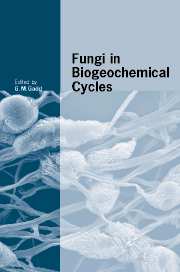Book contents
- Frontmatter
- Contents
- List of Contributors
- Preface
- 1 Geomicrobiology: relative roles of bacteria and fungi as geomicrobial agents
- 2 Integrated nutrient cycles in boreal forest ecosystems – the role of mycorrhizal fungi
- 3 Fungal roles in transport processes in soils
- 4 Water dynamics of mycorrhizas in arid soils
- 5 Integrating ectomycorrhizal fungi into quantitative frameworks of forest carbon and nitrogen cycling
- 6 Role of arbuscular mycorrhizal fungi in carbon and nutrient cycling in grassland
- 7 The role of wood decay fungi in the carbon and nitrogen dynamics of the forest floor
- 8 Relative roles of bacteria and fungi in polycyclic aromatic hydrocarbon biodegradation and bioremediation of contaminated soils
- 9 Biodegradation and biodeterioration of man-made polymeric materials
- 10 Fungal dissolution and transformation of minerals: significance for nutrient and metal mobility
- 11 Fungal activities in subaerial rock-inhabiting microbial communities
- 12 The oxalate–carbonate pathway in soil carbon storage: the role of fungi and oxalotrophic bacteria
- 13 Mineral tunnelling by fungi
- 14 Mineral dissolution by ectomycorrhizal fungi
- 15 Lichen biogeochemistry
- 16 Fungi in subterranean environments
- 17 The role of fungi in carbon and nitrogen cycles in freshwater ecosystems
- 18 Biogeochemical roles of fungi in marine and estuarine habitats
- Index
- References
17 - The role of fungi in carbon and nitrogen cycles in freshwater ecosystems
Published online by Cambridge University Press: 10 December 2009
- Frontmatter
- Contents
- List of Contributors
- Preface
- 1 Geomicrobiology: relative roles of bacteria and fungi as geomicrobial agents
- 2 Integrated nutrient cycles in boreal forest ecosystems – the role of mycorrhizal fungi
- 3 Fungal roles in transport processes in soils
- 4 Water dynamics of mycorrhizas in arid soils
- 5 Integrating ectomycorrhizal fungi into quantitative frameworks of forest carbon and nitrogen cycling
- 6 Role of arbuscular mycorrhizal fungi in carbon and nutrient cycling in grassland
- 7 The role of wood decay fungi in the carbon and nitrogen dynamics of the forest floor
- 8 Relative roles of bacteria and fungi in polycyclic aromatic hydrocarbon biodegradation and bioremediation of contaminated soils
- 9 Biodegradation and biodeterioration of man-made polymeric materials
- 10 Fungal dissolution and transformation of minerals: significance for nutrient and metal mobility
- 11 Fungal activities in subaerial rock-inhabiting microbial communities
- 12 The oxalate–carbonate pathway in soil carbon storage: the role of fungi and oxalotrophic bacteria
- 13 Mineral tunnelling by fungi
- 14 Mineral dissolution by ectomycorrhizal fungi
- 15 Lichen biogeochemistry
- 16 Fungi in subterranean environments
- 17 The role of fungi in carbon and nitrogen cycles in freshwater ecosystems
- 18 Biogeochemical roles of fungi in marine and estuarine habitats
- Index
- References
Summary
Introduction
Fungi are adapted to a diverse array of freshwater ecosystems. In streams and rivers, flowing water provides a mechanism for downstream dispersal of fungal propagules. The dominant group of fungi in these habitats, aquatic hyphomycetes, have conidia that are morphologically adapted (tetraradiate and sigmoid) for attachment to their substrates (leaf litter and woody debris from riparian vegetation) in flowing water (Webster, 1959; Webster & Davey, 1984). In freshwater wetlands and lake littoral zones, production of emergent aquatic macrophytes is often extremely high, resulting in an abundance of plant material that eventually enters the detrital pool. The dead shoot material of these macrophytes (leaf blades, leaf sheaths and culms) often remains standing for long periods of time before collapsing to the sediments or water. This plant matter is colonized by fungi that are adapted for surviving the harsh conditions that prevail in the standing-dead environment (Kuehn et al., 1998). There are a number of other freshwater ecosystems where fungi are present and exhibit interesting adaptations, e.g. aero-aquatic fungi in woodland ponds, zoosporic organisms (Chytridiomycota and Oomycota) in a variety of habitats including the pelagic zones of lakes, and Trichomycetes that inhabit the guts of a variety of aquatic insects. Despite the well-known occurrence of these fungal groups in aquatic habitats, virtually nothing is known concerning their roles in biogeochemical processes. Overall, the contributions of fungi to biogeochemical cycles have been understudied in most freshwater ecosystems.
- Type
- Chapter
- Information
- Fungi in Biogeochemical Cycles , pp. 404 - 435Publisher: Cambridge University PressPrint publication year: 2006
References
- 30
- Cited by



